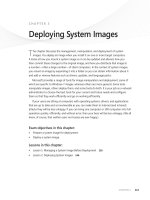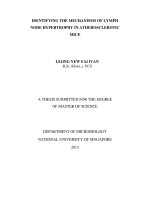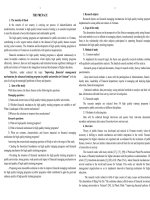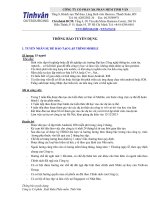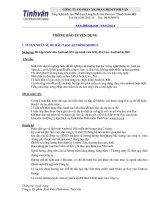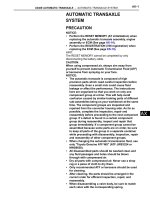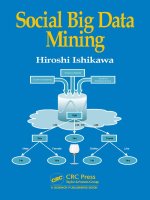15 hypertrophy training mechanisms
Bạn đang xem bản rút gọn của tài liệu. Xem và tải ngay bản đầy đủ của tài liệu tại đây (653.97 KB, 13 trang )
UNIVERSITY
Hypertrophy
Training
Mechanisms of
hypertrophy and
application to training
The Lesson
•The hypertrophy stimulus
•Mechanisms of hypertrophy
•How a muscle contracts
•Types of muscle growth
•How hypertrophy mechanisms relate to
training
•The variables to manipulate in training
Stimulus to Fatigue
Overload: Acute disruption to homeostasis ie resistance training stress
Adaptation: Process leading to functional improvement in
performance
Fatigue: reduction in the capacity to produce performance ie strength
(fitness)
Recovery: return to previous performance levels or better prior to
disruption
We want the RIGHT amount of stimulus to create a hypertrophy
adaptation! Then manage fatigue to create another overloading
hypertrophy stimulus again
Performance
Training
Overload
Stimulus
Fitness (gains)
Time
Fatigue
Recovery
Fitness Fatigue Model
What is the Hypertrophy Stimulus?
Initial Stimulus > Molecular Signaling > muscle protein synthesis
Initial Stimulus:
1. Mechanical Tension (Primary): mechanoreceptors within the
muscle sensitive to tension magnitude and duration at the fiber
level.
2. Metabolic Stress: accumulation of metabolites during training
(lactate, H+, inorganic phosphates) generating fatigue
3. Muscle Damage: Disruption to muscle fiber structure
All 3 occur simultaneously at varying degrees and metabolic stress and
muscle damage may be more related to effects of imposed mechanical
tension on fibers
Potentials for Metabolic Stress and Muscle
Damage
Metabolic Stress
Increased fiber recruitment
Increased myokine production
Increased cell swelling
Increased GH and testosterone levels
Concentric muscle contractions most energetically demanding
Higher repetition training, closer to failure, BFR, Super sets, drop sets
*additive effective to hypertrophy still uncertain
Muscle Damage
Increased inflammatory initiation
Satellite cell activity
Cell swelling
Too much damage limits hypertrophy
Eccentric muscle contraction most damaging
*Side effect of tension forces from contraction
Types of Hypertrophy
Muscle hyperplasia: increase in muscle cell number, evidence limited
and not a primary contributor to growth
Myofibrillar hypertrophy: increase in size and amount of contractile
elements of skeletal muscle.
Sarcoplasmic hypertrophy: increase in all cellular components
(ribosomes, anerobic metabolism enzymes, T-tubules, etc)
Myofibrillar, fiber #
increase, sarcoplasm
unchanged
Sarcoplasmic, sarcoplasm
increases, fiber #
unchanged
How Does a Muscle Produce Tension/Contract?
Muscle contracts (shortens and lengthens) by sliding filaments (actin and
myosin) binding together and pulling the sarcomere closer together
Motor units are the nerve cells and muscle fibers they innervate. You have
small and large motor units that can innervate 2-3 fibers or up to 1000s of
fibers.
What Determines Level of Tension in a
Muscle?
More External Resistance DOES NOT mean more internal tension
1. Size Principle: Recruit low and high threshold motor units to have
all fibers exposed to tension. The motor units are activated in
order from small (low threshold) to large (high threshold)
depending on the amount of force needed and rate of force.
“Henneman’s Size Principle”.
2. Force-Velocity Relationship: The fibers then must be contracted at
highest forces possible which also means slow velocities as slow
velocities allow for more binding of actin and myosin filaments
3. Length-tension Relationship: muscles produce more force at
certain lengths. More force is produced at longer muscle length.
Long muscle lengths also add a passive force from the “stretch
tension” add to the active tension of a muscle contracting.
4. Internal moment arm: The leverage of a muscle on a joint
determines degree of force needed to create torque at the joint.
5. Fatigue: Causes early recruitment of high threshold motor units,
reduces contraction ability of fibers requiring unfatigued fibers to
contribute to force production.
How Do You Create High Tensions Lifting
Weights?
Hard sets! A set must be very challenging and close to muscular failure
to recruit high threshold motor units (HTMU) and maximal tension via
slow velocities.
Heavy loads >85% (1-5RM) will recruit HTMU early in the set and all
reps will be stimulating via high tension
Light (15+ 1RM ) and moderate (6-15RM) loads will recruit HTMU later
in the set as fatigue is generated and more fibers must contribute to
keep muscle contraction occurring. So, the later reps will be more
stimulating and early reps not as much.
This gives notion to the idea of “effective” or “stimulating reps”
One set provides a level of magnitude of tension that increases as we
approach muscular failure and the muscle fibers have a longer time
duration of exposure to that tension.
Is There a Dosage of Tension For Growth?
Hypertrophy
RATE OF
GROWTH
Atrophy
No Sets
Optimal Sets
Too Many Sets
Volume Dosage Inverse U shaped Curve
Programming Variables for Tension Stimulus
Volume: Dosage of stimulus = # of hard sets
Intensity: Degree of stimulus magnitude = % 1 rep max and proximity
to failure
Frequency: Organization of stimulus = training split
Exercise Selection: Regional stimulus= movement pattern choice and
muscles it involves
Exercise execution and tempo: Focus of stimulus = way in which you
move during a repetition and intention
Exercise order: Stimulus sequence and effectiveness = order of
movements
Rest periods: Removal of stimulus= time between sets
Summary
The main driving mechanism for hypertrophy is mechanical tension
Mechanical tension can be created with heavy and light load sets
taken near or at proximity to muscular failure
A certain number of “hard sets” is needed to optimize hypertrophy
Metabolic stress and muscle damage may be additive factors to
hypertrophy, but may also only be resultant factors of mechanical
tension
Programming variables for hypertrophy revolve around how we will
apply tension (stimulus) in an organized manner.
Let’s Program!
Reference
Encyclopedia Britannica. striated muscle; human biceps muscle.
Available at:
/>9 Access Date: July 28th 2020.
Schoenfeld B. Science and Development of Muscle Hypertrophy.
Champaign, IL: Human Kinetics; 2021.
Beardsley, C. Hypertrophy: Muscle fiber growth caused by mechanical
tension. Strength and Conditioning Research Limited, 1 edition; 2019.

